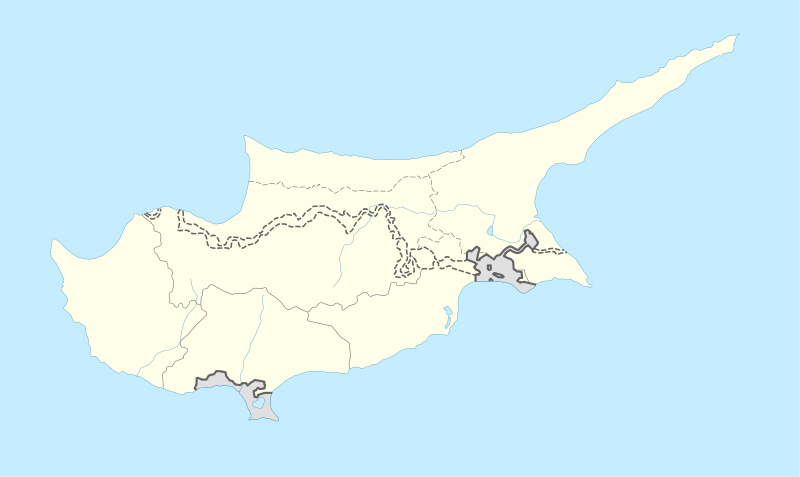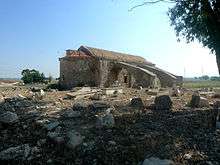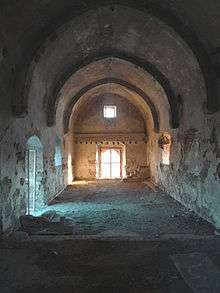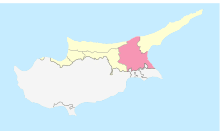Angastina
Angastina (Greek: Αγκαστίνα, Turkish: Aslanköy) is a village in the Famagusta District of Cyprus, located around 20 km east of Nicosia, on the main road to Famagusta. It is under the de facto control of Northern Cyprus. Angastina is perched on a gentle river terrace chalk escarpment over the Pedias river plain at 66 metres above sea level.
Angastina | |
|---|---|
village | |
| Αγκαστίνα (Greek) Aslanköy (Turkish) | |
Angastina, Cyprus, 2012. Viewed from the northern Nicosia to Famagusta highway. Note the bell tower of Agia Paraskevi right of the communications tower | |
 Angastina Location in Cyprus | |
| Coordinates: 35°12′8″N 33°35′11″E | |
| Country (de jure) | |
| • District | Famagusta District |
| Country (de facto) | |
| • District | Gazimağusa District |
| Time zone | UTC+2 (EET) |
| • Summer (DST) | UTC+3 (EEST) |
Etymology

It was suggested by Nearchos Clerides, in Villages and Cities of Cyprus, that Angastina had been named from the Frank word gastina for crust. This alludes to the thick rocky shell rock (kafkala-Greek Cypriot for crust) that covered the surrounding mesas and on which the last version of the village was built. He suggested that name was modified by the locals and made their own by adding the A.[2] This is possible as the nearby village of Mora was "entirely a Frankish town under Frankish occupation. It was owned by the House of Moravit and it was named Mora for short. Cyprus at that time was ruled by the French House of Lusignan." The Franks arrived in Cyprus "in the high and late Middle Ages, between 1192 and 1489. However, George Jeffrey speculated that the name (on ancient maps "Angestrina ") may be from "neo-latin origin (1500–1900)".[3] Christos Diakos in Angastina - History and Traditions agreed, pointing out that "The church of Agios Therapon existed at our village since Byzantine time.[4]
The name of the village was Agios Therapon. The name Angastina appears at the time of the Venetians.[5] The main church of Angastina up to 1974 was Agia Paraskevi, which has since been converted into a mosque.
Whatever is the case, Angastina is renowned for its long history which goes back to prehistoric times. Until 1950 it was on the rail line that connected Famagusta and Nicosia but now on that same carriageway is built a modern motorway.[6][7]
History
Early history


Angastina is renowned for its Cypro-Mycenaean (10,000-800 BC) archaeological burial site of Vouno which was excavated 2 km east of the village in the 1962 when the new road to Famagusta was put through. According to Georgious Kyriakos in Cyprus Heritage, at the Cyprus Museum there are artifacts found in Vouno, such as "A Composite vase of White Painted V ware. It consists of four spherical parts joined to a common neck with a pinched mouth. A female figurine is attached to the neck; her right hand holding her breast and the left her abdomen." This dates from the Middle Cypriot III period (1725–1625 BC).
During the Crusades, the village or near it was a fort for the cavalry of the Knight Templars (1291) and locations still bear within living memory such names as The Stables of the Kavalirides (the stables of the cavalry) or The Kavalarides.[8] [9]
However Angastina was not always perched over the plains. There are still remnants of an older location of the village, to the south east towards Assia, which are still called Halospita (Ruined Houses). It is thought that either the devastation of The Plague in the 1430s or flooding from the Pedias River forced the original inhabitants to relocate the village to its present location: Latitude 35.204 and Longitude 33.583, about 70 metres above sea level.
The murder of Nikoli Philippou
As many other villages in Cyprus, Angastina, until 1907, was bi-communal. On 17 August of that year a murder occurred that would eventually drive a wedge between the village's Christian and Muslim communities. A young Turk fell in love with a married Greek woman. He was warned off but took it to heart and stupidly fired upon a company of young Greek men very late at night while they were having a coffee in the village square. One the Greek young men suspecting the young Turk took the Police to the young Turk's house. The young Turk confessed and the father offered monetary retribution. The young Greek man refused to be bought off by the father so the young Turk was arrested by the Police. The father was furious that the young Greek man would not accept the money. That night he went with his son inlaw to the threshing field which the young Greek man was guarding with his mother-in-law nearby. The Turkish father murdered him while he was asleep by bashing his head in with a rock. Eventually the Turkish father was arrested and he and his son in law were tried, sentenced and hung by the British authorities of the island. The whole story is recorded in the ballad "The murder of Nikoli Philippou" by C. T. Palaisi[10] written at the time and the local press.[11] After that event all Turkish Angastiniotes sold up and moved to nearby Turkish villages.
The Turkish invasion of 1974
Since the Turkish invasion in 1974, the village has been inhabited by Turkish Cypriots and Turkish mainland settlers.[12]
Agriculture
Angastina is famous for its vineyards and until World War II cotton was grown extensively in the area.[13] Wheat, barley and lentils were the main cereals grown before the 1974 Turkish invasion.
Famous Angastiniotes
Angastina has produced several renowned artists, poets and entrepreneurs. The monk brothers Chariton (1887–1973), Stephanos (1894–1974) and Barnabas (1897–1974) who chose the monastery Apostle Barnabas, in Enkomi, as their presbytery were famous for their icons. Some they painted to decorate the ancient church and others they sold to buy materials and other provisions. "The most popular saints they paint(ed) are the Apostle Andrew, Blessed Virgin Mary, and Saint George."[14]
The primitive sculptor Kostas Nicoli Papa, who was recognised for his work in an exhibition in Ashia in 1946 was born there. 34 The writer and poet Kostas Pousis, educationalist expatriated artist Grigoris Kikillos, the naïve artist Nicos Nicolaides (1884–1956), politician and poet Andreas Kokoumas (1947- )(Antis)[15] were also born in Angastina as was the well known business entrepreneur Photos Photiades. In 1997, Christos G. Diakos published, in Greek, a history of the village named Angastina-History and Tradition.
Churches
- Agia Paraskevi - Greek Orthodox church - converted into a mosque by after Turkish invasion in August 1974. It was built in 1878 on an older church of the same name. The building 9of the Church was supervised by Master-mason Giakoumis Psoris.[16] In 1920 a lightning strike felled the bell tower and between 1957 and 58 a new bell tower was erected. See photograph to the right taken in 2012 that verifies its current status as a Mosque. Note the absence of a cross on the bell tower and the presence of a megaphone that is used by the Imam to call Muslim faithful to prayer.
- Agios Therapon - Greek Orthodox church and cemetery.
References
- In 1983, the Turkish Republic of Northern Cyprus unilaterally declared independence from the Republic of Cyprus. The de facto state is not recognised by any UN state except Turkey.
- Clerides, Nearchos (1961). Villages and Cities of Cyprus.
- Jeffrey, George (1918). A description of the historic monuments of Cyprus.
- Diakos|first=Christos|title=Angastina-History and Tradition, 1997, pp. 9-10.
- Diakos, Christos (1997). Angastina-History and Tradition.
- Flourentos, Pavlos (1996). Cyprus Heritage.
- "Archived copy". Archived from the original on 14 July 2014. Retrieved 15 September 2012.CS1 maint: archived copy as title (link)
- "Angastina-The Village of the Lotus Eaters". wix.com.
- Clirides, Nearchou (1961). Villages and Cities of Cyprus.
- Giagkoulli K.G. Corpus Cypriot Dilalect Poetic Pieces, Centre of Scientific Research, 1998, pp. 76–79. ISBN 9963-0-8042-1
- Elephteria (Newspaper), Nicosia, Cyprus, 16 and 30 November 1997.
- Cyprus. Grapheion Dēmosiōn Plērophoriōn (1979). Colonisation of occupied areas. Public Information Office. p. 3.
- General History of Cyprus, Published 185, Alexandria.
- Keshishian, Kevork.K. Romantic Cyprus, 11th edition, 1963, pp. 161–162.
- Andreas Koukouma
- Diakos, Christos-

